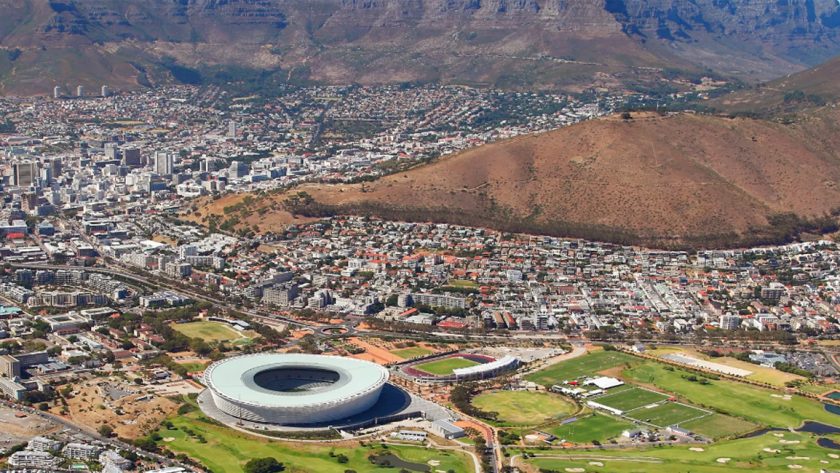For decades, the world has defined South Africa by its social and political dramas. It is quite possible to observe these realities while touring the area. But while traveling by car, people are scarce and land plentiful. It is easy to be consumed by the landscapes. And South Africa lends itself to the cataloguing of vistas.
Although the colonial period of South Africa began some 500 years ago, the primary immigrants were farmers rather than builders of empires. Few indelible steps in the march of European architecture exist and Africa’s own past is retained in subtleties too slow for rental car vacationers. It seems nothing is old in the country, save for high piled rocks on dry fat land, a testament to receding waters. The many dramatic mountains, plateaus, gorges and waterfalls speak of the ages and emphasize the presence of land beyond the call of country.
For better or worse, renting a car allows you to see exactly what you want, avoiding all the uncomfortable situations that add dimension to a place. It is like looking at a gallery of landscape pictures. Some of which strike tearfully beautiful; some are whole tedious rooms of dusty rubble. From a car it is difficult to experience other than visually. A bit like a library, landscapes may be referenced or recalled and totally foreign chapters opened, all observed through the same windows, within the same walls. Development may be tracked along a geographical line. Conclusions drawn according to marked distances traveled.
This phenomenon is not specific to South African travel, but this country’s encyclopedia of landscapes asks to be visually studied. only about twice the size of Texas, South Africa seems to contain landscapes comparable to each of those experienced in the United States. In many ways it is remarkably similar to America with the hundreds of miles of consistency cut out so that each biome is stacked close against the next. It is said by locals that a person cannot travel more than 80 kilometers without the landscape drastically changing.
The West Coast is washed by the Benguella current from Antarctica and keeps the shoreline perpetually cool. A person can stand on a mountain of shells on a rock outcropping at the West Coast National Park and look across the breaking water to a tiny rock island with some ruined stone buildings and stone walls. With binoculars it is possible to see a vague commotion on the beach, and some careful scanning will reveal swimming penguins. Seascapes are so untouchable. Distance is lost to the immensity of the panorama and the rhythm of the water is a pattern, arresting all the picture’s motion. But those swimming auks divide the space, deliberately upsetting the waters texture. They create a midpoint between shore and island, and place the island between themselves and the horizon. The swimmers make it obvious that the movement on the beach is a colony of the birds; the planes are traversable, and a logic is established among the elements. When immersed in even a foreign landscape it quickly becomes visually familiar. If a real interest is taken in the birds present the whole scheme is immediately recharged. And for every element that is given special priority the landscape freshens. In this way an avid birder may be fascinated by a relatively uninteresting area because of the presence or mere probablity of birdlife. Likewise a botanist may thrill at the most desolate karoo rubble because of the mind boggling variety of succulents present.
South Africa’s natural beauty bears the brunt of its tourist industry. The market really hinges on the indigenous mammals. People without prior interest in nature viewing are attracted to the novelty of these animals and find themselves spending days scrutinizing the landscapes. When one sees the first hyena part the plane of grass, the use of all that land becomes implicit; the landscape becomes a habitat, and what was formally appreciated gains content: untouched natural landscape is sustaining man and beast alike. South Africa is well aware of the profits in not developing certain areas and offering a glimpse of what it has naturally.
There is a human hand and some social responsibility behind every stretch of horizon we can lay eyes on. Sometimes it makes no attempt to disturb the simple appreciation of light fall on line and colors; other times it is a memento of man’s presence requiring only an acknowledgement. Much of South Africa is a bed of agriculture from golden waves of grain to pocket vineyards in the cool wet mountains, to dense forests for lumber to prickly pear orchards of the arid interior to coastal displays of subtropical sugar cane. It is impossible to discount the effect of cultivation on South Africa landscape. Like it or not, crops are the fodder of modern landscapes, and at times, the farmer’s field is an aesthetic improvement over nature’s first hand. Then there is architecture, commemorating humanity’s permanence. Finally undeniably historical, the element of architecture recalls some memorable past or holds the viewer to present. African natives have no architecture; they produce pastoral extensions of the landscape and they mark the historical change of available materials.
The Transkeii, spanning a stretch of southeastern coast, has almost entirely been left to Africans and shows few signs of the Western influence developing the rest of the country. The people primarily dwelling around the area of Coffee Bay are Xhosa, living and building clay huts with grass roofs. When scanning a landscape with huts in the area you find no discrepancy between color or texture; the line varies slightly as it traces the dwelling, but no unnatural geometry explains man as a lonesome anomaly. Steep rolling hills, too round to be mountains, carpeted in green grass, peppered with roaming livestock and randomly placed huts are impressively congruous. on the other hand, surrounding the urban centers across the country natives are still building with gifts from the land, unfortunately these amount to urban refuse. As a metropolis sheds toward its edges and peters out to straggling industry the flow is dammed and collected in tin shantytowns. Such communities are not illogical, but embody the term “marginal” like nothing in America. From just one point the human periphery reveals modern architecture, commercial industry, leaning corrugated sheet metal homes and the emptiness of unclaimed grasslands.
The Afrikaans may not have been empire builders but certainly builders by necessity. Their culture is the architecture of southern Africa, an imposition cut and pasted, reinforced, revised, delineated and permanently fixed in position. They are not relatives of the landscapes but toilers, humankind convinced of difference, working hard to organize the world’s disparate elements into functional relationships. Visually, the homes, cities and people are a different texture adding richness to a very busy composition.
The tourist’s relationship to a foreign environment can be intimate or casual. At the very least he visually takes note of differences. His responsibility lies in looking. Horizon and arrangement of elements make almost all landscapes relative. South Africa’s physical and social variety make it take some unique shapes, and it is the virtue of foreign travel to expose the inevitably sight-specific nature of landscape, and the marriage of culture and location.



